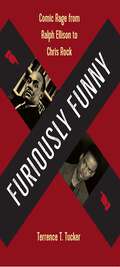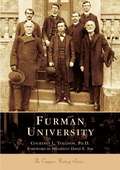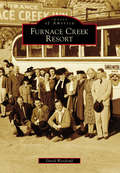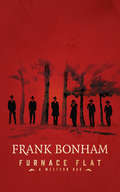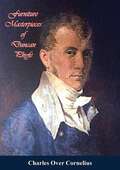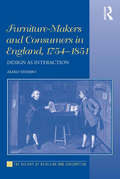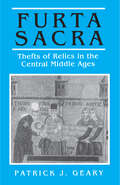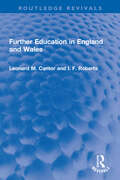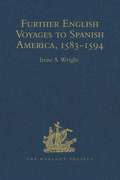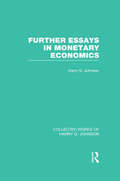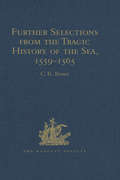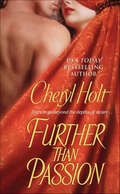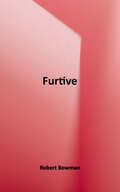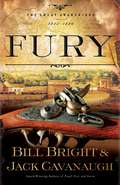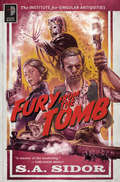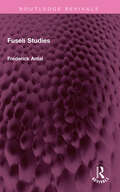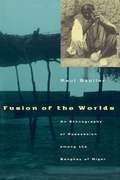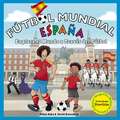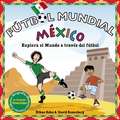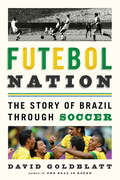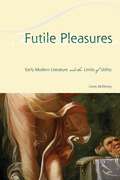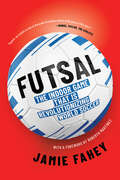- Table View
- List View
Furiously Funny: Comic Rage from Ralph Ellison to Chris Rock
by Terrence T. Tucker"An important and timely expansion of American racial discourse. Tucker’s demonstration of how the comic is not (just) funny and how rage is not (just) destructive is a welcome reminder that willful injustice merits irreverent scorn. "—Derek C. Maus, coeditor of Post-Soul Satire: Black Identity after Civil Rights "Adroitly explores how comic rage is a skillfully crafted, multifaceted critique of white supremacy and a soaring articulation of African American humanity and possibility. Sparkling and highly readable scholarship."—Keith Gilyard, author of John Oliver Killens: A Life of Black Literary Activism A combustible mix of fury and radicalism, pathos and pain, wit and love—Terrence Tucker calls it "comic rage," and he shows how it has been used by African American artists to aggressively critique America’s racial divide. In Furiously Funny, Tucker finds that comic rage developed from black oral tradition and first shows up in literature by George Schuyler and Ralph Ellison shortly after World War II. He examines its role in novels and plays, following the growth of the expression into comics and stand-up comedy and film, where Richard Pryor, Spike Lee, Whoopi Goldberg, and Chris Rock have all used the technique. Their work, Tucker argues, shares a comic vision that centralizes the African American experience and realigns racial discourse through an unequivocal frustration at white perceptions of blackness. They perpetuate images of black culture that run the risk of confirming stereotypes as a means to ridicule whites for allowing those destructive depictions to reinforce racist hierarchies. At the center of comic rage, then, is a full-throated embrace of African American folk life and cultural traditions that have emerged in defiance of white hegemony’s attempts to devalue, exploit, or distort those traditions. The simultaneous expression of comedy and militancy enables artists to reject the mainstream perspective by confronting white audiences with America’s legacy of racial oppression. Tucker shows how this important art form continues to expand in new ways in the twenty-first century and how it acts as a form of resistance where audiences can engage in subjects that are otherwise taboo.
Furman University (The Campus History Series)
by Courtney L. TollisonFounded in 1826 by a group of South Carolina Baptist Convention leaders, Furman Academy and Theological Institution was named after Richard Furman, the first president of the first national gathering of Baptists in the United States. Furman currently resides several miles north of Greenville, as it has since the 1950s, though it has changed locations and names several times since its founding and disaffiliated from the Baptist Convention in 1992. Well known for its beautiful campus, impressive academics, and successful alums, Furman is one of the top 50 liberal arts colleges in the country and was ranked fourth in the country in U.S. News and World Report's "Undergraduate Research" category.
Furnace Creek Resort: A History Of Furnace Creek Resort And Its Evolution Into The Oasis Of Death Valley (Images of America)
by David WoodruffSince opening on February 1, 1927, with just 12 guest rooms, Furnace Creek Resort has achieved preeminence among US National Park lodges and hotels. Conceived by the Pacific Coast Borax Company in 1926, the inn was the answer to the declining mining industry, which had left the Death Valley Railroad with nothing to haul. The construction of Furnace Creek Inn helped to shift Death Valley's draw from mining to tourism, bringing a new industry to the Old West. Steeped in history and tradition, the inn and the ranch have become as much a destination as the park itself. With naturally heated swimming pools, the world's lowest golf course, four-diamond hospitality, and surroundings of unsurpassed natural beauty, Furnace Creek offers experiences that are long remembered by its guests.
Furnace Flat: A Western Duo
by Frank Bonham Traber Burns“Sergeant Forson’s Dirty-Shirt Army” is set in eastern Oregon, at a forgotten outpost left behind by the regular Army during the War between the States. Fort Haney is now home to a troop of fifty-seven men, raw recruits in the Oregon Volunteer Cavalry, who care little about fighting except among themselves, in spite of the fact that they are surrounded by hostile Snake and Cayuse Indians, just waiting for opportune moments to strike at farmers, ranchers, and stagecoaches. Their commanding officer plots strategy by retiring to his quarters, building model ships, and drinking whiskey. What alone can make a difference perhaps is Sergeant Ward Forson, previously trained in the regular Army. When word comes that the daughter of the commanding officer is on her way by stagecoach, coming to Fort Haney, both Major King and Sergeant Forson know that an Indian attack is likely. It is up to Forson to insure that these undisciplined recruits, who have been living almost like animals, will now pull together and meet their adversaries like true soldiers.“Furnace Flat” is set in Death Valley. For twelve years now, Grady Ryan has worked in Borax mines, always with the idea to get a stake and strike off on his own to find a rich lode. He has done this several times in the past, but this time he has reason to expect to find a true bonanza. He is partnered with the elderly Mysterious Smith. Ryan is certain that Smith knows the location of a fabulous lode. And Ryan is right. But Smith knows they will be followed into the desert by ruthless claim-jumpers. His reason for wanting Ryan along is to fight off the claim-jumpers, not to share in a fortune with him. Maggie Conway, who operates a successful hash house in Furnace Flat, from which Grady and Smith are set to depart, is highly intuitive, and she tells Ryan that she is as sure as she has ever been that this time he will make his strike and find success at last. Intuitive she may be, but no fortune-teller.
Furnishing Fascism: Modernist Design and Politics in Italy
by Ignacio G. GalánThe role of modernist interior design in the construction of Italian nationalism Along with the rise of Mussolini&’s fascist regime, the interwar years in Italy also saw the widespread development of its modernist interior design and furnishing practices. While the regime&’s politics were overtly manifest in monumental government architecture, Furnishing Fascism examines the subtler yet effective role of household goods and decor in the cultivation of Italy&’s exclusionary sense of national identity. Presenting a fresh look at the work of various architects and designers, including iconic figures such as Gio Ponti and Carlo Enrico Rava, Ignacio G. Galán explores how seemingly neutral products of everyday life contributed to the propagation of fascist ideology. Through extensive promotion in popular magazines and department stores, on the film sets of Cinecittà Studios, and throughout the country&’s colonial territories, Italy&’s modernist design practices were part of a larger political project that aimed to produce a totalizing image of cultural hegemony. Interweaving design theory, architectural history, and media scholarship, Furnishing Fascism reexamines the period&’s so-called minor arts to reveal the political entanglement of modernism in early twentieth-century Italy and offers valuable insight into the complications of cultural production under the auspices of authoritarian power. Retail e-book files for this title are screen-reader friendly with images accompanied by short alt text and/or extended descriptions.
Furniture Masterpieces of Duncan Phyfe [Illustrated Edition]
by Charles Over CorneliusThis well-known reference work has been consulted by generations of collectors, curators, dealers, historians, and craftsmen, and it remains in use decades after its initial publication. Photographs and measured drawings of the most striking furniture pieces of the sixteenth through nineteenth centuries constitute the major part of the book; the accompanying text indicates stylistic features and developments, prototypes, types of wood, function, and location of the original. Selected mainly from collections in the Metropolitan Museum of Art, Boston Museum of Fine Arts, and the Museum of the Rhode Island School of Design, the objects include chests, tables, chairs, dressing tables, desks, highboys, commodes, couches, and other furniture. Periods and styles include Colonial American, Duncan Phyfe, Windsor, Sheraton, Hepplewhite, Chippendale, Louis XIV, eighteenth-century Dutch, sixteenth-century Italian, and representatives of other eras. The book's most outstanding features are the measured drawings for each piece of furniture. Accurate to the nearest 1/16th of an inch, these drawings are especially valuable for woodworkers creating detailed replicas.-Print ed.
Furniture-Makers and Consumers in England, 1754–1851: Design as Interaction (The History of Retailing and Consumption)
by Akiko ShimboCovering the period from the publication of Thomas Chippendale's The Gentleman and Cabinet-Makers' Director (1754) to the Great Exhibition (1851), this book analyses the relationships between producer retailers and consumers of furniture and interior design, and explores what effect dialogues surrounding these transactions had on the standardisation of furniture production during this period. This was an era, before mass production, when domestic furniture was made both to order and from standard patterns and negotiations between producers and consumers formed a crucial part of the design and production process. This study narrows in on three main areas of this process: the role of pattern books and their readers; the construction of taste and style through negotiation; and daily interactions through showrooms and other services, to reveal the complexities of English material culture in a period of industrialisation.
Furta Sacra: Thefts of Relics in the Central Middle Ages - Revised Edition
by Patrick J. GearyTo obtain sacred relics, medieval monks plundered tombs, avaricious merchants raided churches, and relic-mongers scoured the Roman catacombs. In a revised edition of Furta Sacra, Patrick Geary considers the social and cultural context for these acts, asking how the relics were perceived and why the thefts met with the approval of medieval Christians.
Further Education in England and Wales (Routledge Revivals)
by Leonard M. Cantor I. F. RobertsFirst published in 1972, this second edition of Further Education in England and Wales was written to provide a comprehensive account of the character and extent of further education in England and Wales. The book critically analyses the major features of further education at the time of publication, and suggests ways in which it might profitably develop in the years ahead. It provides an important account of the post-war historical background to further education, and examines in detail topics such as the role of polytechnics and the work of the Council for National Academic Awards; the educational implications of the Industrial Training Act; developments in education for business and management; and, the changing pattern of education for art and design. The book also considers the training of teachers for further education, and further education in Wales.
Further English Voyages to Spanish America, 1583-1594: Documents from the Archives of the Indies at Seville illustrating English Voyages to the Caribbean, the Spanish Main, Florida, and Virginia (Hakluyt Society, Second Series #99)
by Irene A. WrightTranslated and edited. For other selections, see Second Series 62, 71, 111. This is a new print-on-demand hardback edition of the volume first published in 1951.
Further Essays in Monetary Economics: Further Essays In Monetary Economics (Collected Works of Harry G. Johnson)
by Harry G. JohnsonA sequel to Essays in Monetary Economics, this book develops the ideas on domestic and international monetary issues, with reference to specific events and crises of the 1960s and 70s. These essays are distinguished by the author’s expert grasp of the analytical techniques and contemporaneous policy problems of both domestic and international monetary economics.
Further Selections from the Tragic History of the Sea, 1559-1565: Narratives of the Shipwrecks of the Portuguese East Indiamen Aguia and Garça (1559), São Paulo (1561) and the Misadventures of the Brazil-ship Santo Antonio (1565) (Hakluyt Society, Second Series #132)
by C. R. Boxer'Being about to write down the disastrous voyage of this great ship, it occurred to me how rash men are in their undertakings, chief among which, or one of the greatest is confiding their lives to four planks lashed together, and to the discretion of the furious winds.' So wrote Henrique Dias, an eye-witness of the wreck of the Sao Paulo off Sumatra and the subsequent fate of the survivors. His account is one of three narratives, here translated into English for the first time, of certain shipwrecks which befell the Portuguese in the mid-16th century. The other two describe the wrecking of two East Indiamen off the East African coast, and the misadventures of a voyage from Brazil to Lisbon. In his introduction, Professor Boxer describes the lives of the three chroniclers, and gives bibliographical details of their works. The narratives are translated from the original accounts which Bernardo Gomes de Brito included in his História Trágico-Marítima (Lisbon, 1735-36). The present volume forms a companion to Professor Boxer's earlier work The Tragic History of the Sea, 1589-1622 (Hakluyt Society, 1959). This is a new print-on-demand hardback edition of the volume first published in 1968.
Further Than Passion
by Cheryl HoltKate Duncan agrees to help her young cousin land a husband though she draws the line when she learns the foolish girl wants to use an apothecary's love potion to snag the notorious Marcus Pelham! To prove the elixir a fake, Kate drinks it herself-and experiences the most erotic moment of her life when she stumbles upon Marcus in a most compromising position. Every nerve in Kate's body sings as she watches from the shadows, but is her response a result of the potion...or the man? Luckily, Marcus is far too busy to notice Kate's spying-or so she thinks... As the Earl of Stamford, Marcus has his choice of willing ladies to share his bed. Yet nothing has ever aroused him as much as the image of Kate watching him. Marcus tries to have a little fun with Kate by drinking the elixir-and then appearing to lose all control every time she's near. But the prank goes awry when Marcus finds himself wildly and truly attracted to the innocent Kate. As he teaches her the passionate art of seduction, will he lose his heart for the very first time?
Furtive
by Robert BowmanFurtive is the first companion novel for Washington Interactive, the Washington state geography and history curriculum.
Fury
by Bill Bright Jack CavanaughHe just witnessed a murder...and now the killer is on his trail. But no one will believe him! Ever since his parents drowned while crossing the Atlantic after a revival, Daniel Cooper has felt as if the world is out to get him. For the past year he's had to live with his Uncle Asa and Aunt Camilla -- and all their rules. One night, deciding he's had enough, Daniel sneaks out his bedroom window and flees to the alley behind his employer's casket shop. What he sees there shocks him to the core. Pursued by two men, Daniel embarks on an agonizing journey...through deceit and betrayal. A journey that will test his physical stamina and challenge his understanding of God and friendship. A journey that may well change his life...if it doesn't kill him first.
Fury From the Tomb: The Institute for Singular Antiquities Book I (The Institute for Singular Antiquities #1)
by Sa SidorMummies, grave-robbing ghouls, hopping vampires, and evil monks beset a young archaeologist, in this fast-paced Indiana Jones-style adventure Saqqara, Egypt, 1888, and in the booby-trapped tomb of an ancient sorcerer, Rom, a young Egyptologist, makes the discovery of a lifetime: five coffins and an eerie, oversized sarcophagus. But the expedition seems cursed, for after unearthing the mummies, all but Rom die horribly. He faithfully returns to America with his disturbing cargo, continuing by train to Los Angeles, home of his reclusive sponsor. When the train is hijacked by murderous banditos in the Arizona desert, who steal the mummies and flee over the border, Rom – with his benefactor’s rebellious daughter, an orphaned Chinese busboy, and a cold-blooded gunslinger – must ride into Mexico to bring the malevolent mummies back. If only mummies were their biggest problem…File Under: Fantasy
Fuseli Studies (Routledge Revivals)
by Frederick AntalFirst published in 1956, Fuseli Studies deals with the many-sided artistic achievements of Zurich-born Fuseli’s baffling personality, who was one of the most erudite and renowned intellectuals of his day in Europe. The author’s intention has been to place his subject in clear historical perspective within his own epoch, and thus traces Fuseli’s contacts back to sixteenth-century mannerism and forward to twentieth-century expressionism. In this book, the social background of that absorbing period covering the artist’s working years at the turn of the nineteenth century is evoked not only in analysing his style, poised between classicism and romanticism of the age, but also accounting for its appeal and relevance to the present day. This book will be of interest to students of art, art history, European history, and literature.
Fusion of the Worlds: An Ethnography of Possession among the Songhay of Niger (None Ser.)
by Paul Stoller"This ethnography is more like a film than a book, so well does Stoller evoke the color, sight, sounds, and movements of Songhay possession ceremonies."—Choice "Stoller brilliantly recreates the reality of spirit presence; hosts are what they mediate, and spirits become flesh and blood in the 'fusion' with human existence. . . . An excellent demonstration of the benefits of a new genre of ethnographic writing. It expands our understanding of the harsh world of Songhay mediums and sorcerers."—Bruce Kapferer, American Ethnologist "A vivid story that will appeal to a wide audience. . . . The voices of individual Songhay are evident and forceful throughout the story. . . . Like a painter, [Stoller] is concerned with the rich surface of things, with depicting images, evoking sensations, and enriching perceptions. . . . He has succeeded admirably." —Michael Lambek, American Anthropologist "Events (ceremonies and life histories) are evoked in cinematic style. . . . [This book is] approachable and absorbing—it is well written, uncluttered by jargon and elegantly structured."—Richard Fardon, Times Higher Education Supplement "Compelling, insightful, rich in ethnographic detail, and worthy of becoming a classic in the scholarship on Africa."—Aidan Southall, African Studies Review
Fusion of the Worlds: An Ethnography of Possession among the Songhay of Nigeria
by Paul StollerStoller (anthropology, West Chester U.) lived amongst the Songhays intermittently for 18 years. Here he presents a vivid view of a possession cult from an insider's perspective as he recounts the many possession ceremonies he took part in during a drought in 1984.
Futbol Mundial Espana
by Ethan Zohn David RosenbergJourneying to the country that won the 2010 FIFA World Cup, this enlightening handbook explores the culture of Spain through the world's most popular sport: soccer. From watching an amazing game between world class rivals FC Barcelona and Real Madrid to exploring island volcanic landscapes and witnessing the many fiestas that are celebrated there, readers join professional soccer player Ethan Zohn for the experience of a lifetime. Activities generated from each chapter include learning a phrase in each of the different languages spoken in Spain, making a sand-drip sand castle to understand the concept of surface tension, and creating a time capsule unique to a family's culture and era. Readers will also have the opportunity to research a real project in Spain through which they can give back and make a difference in this fascinating country. Viajando al país que ganó la Copa Mundial FIFA 2010, este manual instructivo explora la cultura de España a través del deporte más popular del mundo: el fútbol. Desde ver un partido increíble entre los rivales de primera categoría FC Barcelona y Real Madrid hasta explorar paisajes volcánicos de las islas y participar en las muchas fiestas que se celebran allí, los lectores acompañan al jugador de fútbol profesional Ethan Zohn para una experiencia inolvidable. Algunas de las actividades en cada capítulo incluyen aprender una frase en cada una de las lenguas habladas en España, hacer castillos de arena de goteo para comprender el concepto de la tensión superficial y crear una cápsula de tiempo única a la cultura y la era de una familia española. Los lectores también tendrán la oportunidad de investigar un proyecto real en España a través del cual pueden ofrecer algo a la sociedad y hacer una diferencia en este país fascinante.
Futbol Mundial Mexico
by Ethan Zohn David RosenbergFollowing professional soccer player Ethan Zohn on another global adventure, this entertaining and educational handbook explores the cultures and customs of Mexico. From a walking tour of Mexico City and visits to the ruins of the country's ancient civilizations to a once-in-a-lifetime butterfly migration sanctuary and colorful Lucha Libre wrestling, this investigation explores the real Mexico, avoiding the commonplace tourist traps and border towns. Activities presented in each chapter include science and math projects based on Mayan cultures, creative writing and art exercises inspired by Mexican folk art and celebrations, and even simple traditional recipes. Staying true to its series, this installation provides the opportunity to research a charitable project in Mexico and make a difference in this wonderful country. Siguiendo el jugador de fútbol profesional Ethan Zohn en otra aventura global, este manual educacional y entretenido explora la cultura y las costumbres de México. Desde un recorrido a pie del Distrito Federal y visitas a las ruinas de las civilizaciones antiguas del país hasta un santuario maravilloso para la migración de las mariposas y la lucha libre animada, esta investigación explora el México real y evita las comunes trampas para turistas y las ciudades fronterizas. Las actividades presentadas en cada capítulo incluyen proyectos de la matemática y la ciencia basados en la cultura maya, ejercicios de escritura creativa y arte inspirados por el arte popular y las celebraciones mexicanas y recetas sencillas tradicionales. Manteniéndose fiel a la serie, este libro provee la oportunidad de investigar un proyecto caritativo en México y hacer una diferencia en este gran país.
Futebol Nation: The Story Of Brazil Through Soccer
by David GoldblattNo nation is as closely identified with the game of soccer as Brazil. For over a century, Brazil's people, politicians, and poets have found in soccer the finest expression of the nation's collective potential. <P><P>Since the team's dazzling performance in 1938 at the World Cup in France, Brazilian soccer has been revered as an otherworldly blend of the effective and the aesthetic. <P>"Futebol Nation" is an extraordinary chronicle of a nation that has won the World Cup five times and produced players of miraculous skill, such as Pele, Garrincha, Rivaldo, Zico, Ronaldo, and Ronaldinho. It shows why the phrase "O Jogo Bonito" (the Beautiful Game)has justly entered the global lexicon. Yet there is another side to Brazil and its game, one that reflects the sociological realities.
Futile Pleasures: Early Modern Literature and the Limits of Utility
by Corey McEleneyHonorable Mention, 2018 MLA Prize for a First BookAgainst the defensive backdrop of countless apologetic justifications for the value of literature and the humanities, Futile Pleasures reframes the current conversation by returning to the literary culture of early modern England, a culture whose defensive posture toward literature rivals and shapes our own.During the Renaissance, poets justified the value of their work on the basis of the notion that the purpose of poetry is to please and instruct, that it must be both delightful and useful. At the same time, many of these writers faced the possibility that the pleasures of literature may be in conflict with the demand to be useful and valuable. Analyzing the rhetoric of pleasure and the pleasure of rhetoric in texts by William Shakespeare, Roger Ascham, Thomas Nashe, Edmund Spenser, and John Milton, McEleney explores the ambivalence these writers display toward literature’s potential for useless, frivolous vanity. Tracing that ambivalence forward to the modern era, this book also shows how contemporary critics have recapitulated Renaissance humanist ideals about aesthetic value. Against a longstanding tradition that defensively advocates for the redemptive utility of literature, Futile Pleasures both theorizes and performs the queer pleasures of futility. Without ever losing sight of the costs of those pleasures, McEleney argues that playing with futility may be one way of moving beyond the impasses that modern humanists, like their early modern counterparts, have always faced.
Futility, Or The Wreck of the Titan: Or, Futility
by Morgan RobertsonWhen the "unsinkable" ship the Titan strikes an iceberg, John Rowland, a former naval lieutenant, heroically saves the life of a young girl as the ship founders and eventually sinks, leaving them stranded in the desolate and frigid North Atlantic.Be it mystery, romance, drama, comedy, politics, or history, great literature stands the test of time. ClassicJoe proudly brings literary classics to today's digital readers, connecting those who love to read with authors whose work continues to get people talking. Look for other fiction and non-fiction classics from ClassicJoe.
Futsal: The Story of an Indoor Football Revolution
by Jamie Fahey"All the best players began with futsal!" - Pelé "If it wasn't for futsal, I wouldn't be the player I am today." -- Cristiano Ronaldo The untold story of soccer's little brother futsal, the grassroots game that is the secret behind the success of Pelé, Neymar, Messi, Ronaldo and the US star Christian Pulisic Futsal, a form of indoor soccer, is one of the fastest growing sports in the world. Jamie Fahey uncovers its global stories, tactical innovations and fascinating history and reveals its the secret behind the success of the likes of Brazilians Ronaldhino, Ronaldo Fenômeno and Romario and the kind of soccer revolutionized by Pep Guardiola at Barcelona – with Spain&’s Xavi Hernández and Andrés Iniesta – and at Manchester City, with Belgium&’s Kevin De Bruyne and Brazilian goalkeeper Ederson. As Brazilian superstar Neymar said: &‘It has developed my technique, quick thinking and short moves...Futsal is fundamental to a footballer&’s life. It had a big importance in mine. When you&’re out there playing, you&’re forced to think fast and move even faster – if you lose a second, then the ball will be gone." Born in Uruguay almost a century ago but raised to an art form in Brazil, futsal is one of the fastest-growing sports on the planet: over 60 million people play this lightning-fast and tactically intricate variation of indoor soccer, which is also a bona fide professional sport in its own right. Despite its growing status, however, futsal&’s history remains largely unknown and untold. Jamie Fahey is a leading futsal expert and qualified youth coach. He spent his childhood playing endless soccer matches in the shattered urban landscape of 1980s Liverpool – on the same streets later graced by Wayne Rooney, the &‘last true street footballer&’. Yet when Fahey&’s own soccer career stalled, he realised he had been unwittingly learning the skills that pointed to his true passion. In Futsal: The Indoor Game Revolutionizing World Soccer, Fahey makes the case for futsal&’s transformative grassroots effect, both in the UK and abroad. He also tells the story of futsal&’s politics, tactics and personalities – and in doing so, illuminates a hidden corner of sporting history.
